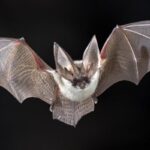We explain everything about spiders, where they live, what they eat and other characteristics. Also, which are the most poisonous spiders.

What are spiders?
The spiders are an immensely large and diverse group of arthropods related to scorpions, ticks and mites (all members of the class arachnid) and very distantly with insects, with which it is important not to confuse them.
Spiders are animals with an important presence in our daily lives, constituting the seventh most diverse order of animals on the entire planet, with more than 46,500 different species classified to date.
In general, however, spiders are small to medium-sized arthropods, famous for their ability to produce a type of silk (spider web) with which they weave networks or traps ready to hunt their prey, since they are important predators of small animals.
To do this, they have a poisonous sting capable of paralyzing their prey. However, given their gigantic variety, spiders can have very different habits, colorations, habitats and levels of danger.
Human beings have known spiders since time immemorial, and gave them a very important presence in culture. Not only as a symbol of industriousness, patience and perseverance, but also as ambassadors of predation, poisonousness and danger, despite the fact that very few species actually represent a risk to human health.
According to the Roman Ovid (43 BC – 17 AD) in his Metamorphosisthe ancient Greeks told the myth of arachnea spinner whose talents were such that she boasted of being better than the gods, to the point of defeating the goddess Minerva in a competition. The latter, offended not only by her defeat but also because Arachne had woven various scenes of gods disguised as animals, turned her into a spider as punishment.
See also: Insectivorous animals
Characteristics of spiders

In general, spiders are characterized by the following:
- Its dimensions generally range between 0.5 mm and 9 cm in length body, although there are exceptional cases of gigantic spiders, capable of reaching 30 cm.
- Since they do not have antennas, Their most developed senses are those of touch and smell which they exercise through their first pair of appendages (pedipalps), since their eyesight is usually rather poor. Despite this, they usually have three to four pairs of eyes, arranged in a very varied way and color.
- In its posterior region have glands capable of secreting silk composed of complex proteins, which in contact with air dry out and harden, forming the well-known “spider web”. Spiders are able to shape attractive webs with it, or use it as an adhesive to make burrows, or as a method of preserving their victims, wrapped in cloth to devour them later.
- Spider venom is made up of a specialized digestive enzyme which paralyzes the victim and in many cases initiates a digestion process that liquefies the insides and allows the spider to slurp the victim's contents without problem. Spiders in general have two types of venom: this one is paralyzing and another has a greater effect, which they use to defend themselves from their multiple predators.
- The spiders have a very limited learning capacity like most arthropods, but at the same time a wide range of instinctive or inherited behaviors, which allow them to imitate other species (ants or wasps, for example) or even lead an aquatic life (skating on the surface of the water, or diving into it with a bubble attached to the abdomen, like a diver). It all depends on the species.
They have a body made up of two parts:
- Cephalothorax (head and trunk in one), from which a pair of chelicerae (mouthparts) arise with which they inject venom into their prey.
- Abdomen from which four pairs of articulated legs arise.
Where do spiders live?
The spiders have a massive presence on all continents, except Antarctica, and in all climates and habitats even in the cold. They are adapted to very different survival models, often at the top of the local food chain, although they also have numerous predators (birds, reptiles, mammals, etc.).
Likewise, many species have adapted to life alongside humans, occupying discreet corners in their homes, while many others maintain their wild life.
What do spiders eat?

They are predators par excellence. Whether they directly attack their prey, or wait patiently for them in the middle of their web, the diet of these animals is made up of insects, other arachnids, worms, larvae, and even, in the largest species, small reptiles or rodents. Furthermore, there are famous cases of spiders in which the female, once reproduction has been completed, devours the male.
How do spiders reproduce?
Spiders reproduce sexually by laying eggs (oviparous reproduction), once the female has been fertilized by the male, inserting his sperm (spermatophores, actually) into the female's sexual tract using one of his pedipalps.
To achieve this, the male must be very careful, since spiders usually consider food to be anything that has the appropriate weight and size, and females are usually much larger than males. Thus, it is common for the male of some species to give the female “gifts”: animals wrapped in silk, so that she is distracted and does not devour him before he has fertilized her.
How long do spiders live?
Most spiders They have relatively short lifespans, rarely exceeding one year. This, of course, depends on each species.
The most poisonous spider species

In a strict sense, all spiders are poisonous, except those belonging to the family Uloboridaebut very few represent a risk to humans since the vast majority of them are incapable of piercing human skin with their chelicerae to inject their venom. Usually, those that actively hunt their prey are more venomous than weaver spiders.
In general, in cases where you receive a spider bite, it usually generates an unpleasant local reaction and nothing more; although many others have stinging villi capable of causing burning only upon contact with the skin.
However, a few species have venoms so intense that they are capable of producing severe poisoning or local necrotic reactions (tissue death) in humans, such as the Australian spiders of the genera Atrax and Hadronyche (about 35 species), or the small spiders of the genus Latrodectus and Loxoscelesmore common and closer to human beings.
The main endangered species are the following:
- Sydney spider (Atrax robustus), native to eastern Australia, which measures between 6 and 7 cm long, and has a coloration between blue-black and bright brown. With aggressive behavior, they are one of the most poisonous spiders in the world, whose bite inoculates variable amounts of neurotoxins, which are very lethal in primates, although much less so in chickens, dogs, cats and other domestic animals. Without specialized medical care, death can occur between 15 minutes and 3 days.
- Australian funnel spider (Hadronyche modesta), native to caves and rocky regions of Australia, is along with the genus Atrax the most abundant and dangerous species on the continent. With nocturnal habits, they produce a venom similar to that of the black widow spider, which luckily has a specific serum with which to treat those affected.
- Southern black widow spider (Latrodectus mactans), the most famous spider in the world, native to American countries such as the United States, Mexico and Venezuela, is a shiny charcoal black with a reddish hourglass-shaped spot on the lower part of the abdomen. Females can measure up to 50 mm in length and although they are nocturnal spiders, rather shy and solitary, the neurotoxic venom they produce is capable of paralyzing the central nervous system and producing enormous muscle pain, as well as triggering hypertensive episodes. However, with proper treatment it is rarely fatal.
- fiddler spider (Loxosceles laeta), also called “Chilean recluse”, is the most dangerous species of its entire genus, whose bite injects protelytic and necrotic substances that can produce serious systemic reactions or death. Native to South America, it lives in nooks and crannies that are difficult to access, and is common in Chile, Peru, Ecuador, Bolivia, Argentina, Paraguay, Uruguay and Eastern Brazil. It measures between 8 and 30 mm long, is brown and has a violin-shaped black line on the thorax.
- banana spider (Phoneutria phera), for many the most poisonous spider in the entire world, is a large, wandering and aggressive species, capable of covering the palm of a hand. Typical of the South American Amazon (Venezuela, Colombia, Peru, Bolivia, Ecuador, Brazil, and northern Argentina), it is capable of running at speeds of 40 kmph with its hairy legs, with light brown markings, and is recognizable by its chelicerae. reddish brown. Its venom is capable of killing a person between 2 and 12 hours of effect without treatment, during which there is a loss of muscle control, intense pain, difficulty breathing and risk of heart attack. Another known effect of its venom is to induce very painful and prolonged erections (lasting at least 4 hours) in men, capable of leaving permanent physical damage.
Continue with: Snake
References
- “Araneae” on Wikipedia.
- “Spiders” in National Geographic.
- “Common spiders” at the University of Kentucky (USA).
- “6 of the most dangerous spiders in the world” on CNN in Spanish.
- “Spider (arachnid)” in The Encyclopaedia Britannica.





